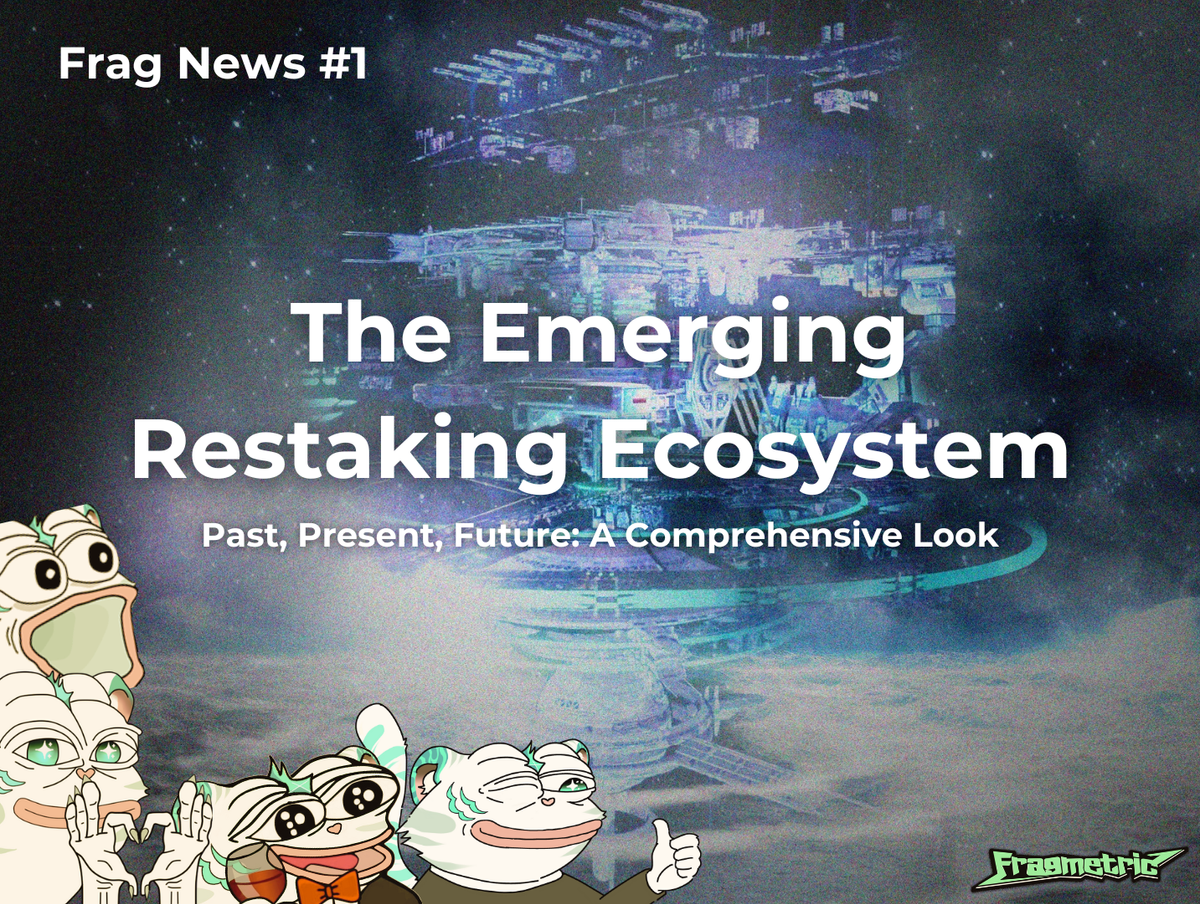
Restaking in Solana began as a way to enhance the staking process and improve network security by allowing stakers to utilize their staked tokens for more rewards. Let’s get you started on the ecosystem. Frag up.
By now, it's clear that Solana is a L1 blockchain known for its outstanding performance, lightning-fast speeds, and remarkable scalability. Designed to cater to decentralized applications and cryptocurrencies, it employs advanced technologies like Proof of History (PoH), Gulf Stream and the Turbine protocol, allowing it to handle an impressive volume of transactions.
As we look to enhance our blockchain investments, restaking emerges as a noteworthy strategy gaining traction in the crypto community. This innovative approach not only boosts the functionality of your staked assets but also has the potential to elevate your rewards while also enhancing the ecosystem security. Let’s dive into the world of Solana restaking and spotlight the key players driving significant developments in this dynamic ecosystem.
When did it start?
Restaking involves utilizing already staked cryptocurrencies to enhance security and operations across various platforms. In early 2023, restaking was popularized on Ethereum, and platforms such as Eigenlayer pioneered the concept of restaking liquid staking tokens. The concept spread rapidly to other networks. Solana was no exception, bringing a new layer of asset utilization. Restaking requires little additional effort—essentially just staking your already staked SOL again—while allowing it to enhance offchain security without sacrificing any original staking benefits.
However, restaking is more intricate behind the scenes, fundamentally acting as a mechanism for shared economic security. To enhance offchain security, restaking leverages a network of operator nodes, which utilize part of their staked Liquid Staking Tokens (LSTs) to perform validations for offchain services. These services—such as oracles, bridges, and smart wallets—rely on the robustness of the node consensus network, thereby ensuring a secure foundation for their operations. In return, these networks provide rewards to the restakers, which should be viewed as compensation for the economic security offered by the delegated LSTs. This creates a synergistic relationship between node consensus networks and restaker, with smart contracts managing these assets within the framework of restaking agreements.
These mechanisms are often challenging to perfect and require expert fine-tuning to maximize earning potential for the restakers. The following restaking protocols are some of the most prominent players within the Solana ecosystem, each creating unique solutions to solidify the restaking landscape
Prominent Players You Should Know
Picasso L1 Protocol

The restaking race in Solana began with Picasso's initial announcement of interest, and now multiple Solana platforms are actively participating in this innovative ecosystem. Picasso first announced their interests in restaking late 2023, and within 4 months launched their protocol onto the mainnet. Their proprietary technology enables secure asset transfers and multi-asset restaking through cross-chain IBC. Though Picasso originally aimed to secure a bridge between Solana and Cosmos ecosystems, they developed into a fully functional restaking service which allows builders to secure their crypto projects using Solana’s security.
1/ 🎨 Reintroducing Picasso: Restaking on @Solana & @IBCprotocol Everywhere.
— Picasso $PICA 🎨 (@Picasso_Network) May 15, 2024
Explore our new website at https://t.co/TGtkxRMGjV and more on our long-term mission 👇https://t.co/GnnOR6uPLF pic.twitter.com/ZijmhXFfL4
Cambrian

Cambrian initially aimed to mirror the success of Ethereum's EigenLayer by tailoring its restaking model to fit Solana's distinct architecture. By emphasizing security layers for various middleware applications, Cambrian establishes itself as a decentralized alternative to prominent cloud service providers like Amazon Web Services (AWS). However, Cambrian has pivoted to pioneer a new segment which enables AVSs to access a larger pool of staked assets from Solana restaking protocols, optimizing development costs.
Solayer

Solayer Labs is an active participant in the Solana restaking ecosystem, actively building an advanced restaking protocol built natively on Solana. They launched their restaking protocol in August of 2024 and have reached $200M TVL by October. Their focus on creating Endogenous AVS facilitates enhanced transaction throughput for native dApps, allowing for tailored blockspace allocation based on delegated stakes. This innovative approach underscores the ongoing evolution of Solana as it expands its capabilities to support a diverse range of decentralized applications.
Recently, Solayer Labs has introduced sUSD, Solana’s first real-world asset-backed stablecoin, pegged to the U.S. dollar and yielding 4-5% from U.S. Treasury Bills. sUSD holders earn rewards from Solayer and partners, with compatibility across platforms like Orca, Perena, RateX Dex, and Phantom. Leveraging Solana's account model, sUSD grows in value through a unique interest-bearing system.
$200m total value locked.
— Solayer (@solayer_labs) September 26, 2024
🧗 pic.twitter.com/6lENnJj9sL
Jito (Re)staking

Jito (Re)staking stands out as a pioneering solution within the Solana ecosystem, offering a highly flexible and lightweight approach for sharing economic security across various on-chain and off-chain activities. Utilizing Jito’s versatile restaking protocol and Vault Receipt Tokens, liquid restaking platforms-like Fragmetric- can enhance the utility of tokens, secure mechanisms, and provide robust risk management features. With Jito’s multi-asset capabilities, Jito (Re)staking leverages staked base assets, including JitoSOL and other SPL tokens, allowing projects to implement customized slashing conditions and nuanced security models tailored to their specific needs. Notably recognized for its MEV optimization and the innovative StakeNet validator set, Jito boasts an impressive Total Value Locked (TVL) of over 13 million SOL, representing more than 50% of the total staked SOL in Solana. By optimizing staked assets and enhancing DeFi capital efficiency through its Vault and Restaking Programs, Jito is poised to play a vital role in the ongoing growth and evolution of the Solana ecosystem.
Jito’s Phase 1 of (Re)staking launched on October 30, allowing users to boost staking rewards while supporting Solana's infrastructure. Deposits, capped at $25 million, were accessible via Jito’s frontend and vault managers Fragmetric, Renzo Protocol, and KyrosFi, accepting $SOL and $SOL LSTs. However, the cap was already hit within a few hours, reflecting the enthusiasm of the community regarding restaking. Audits were conducted by Certora and Osec, with an internal review by Asymmetric.
REMINDER: Jito (Re)staking deposits open October 30th at 11am ET! 💚🥩
— Jito (@jito_sol) October 29, 2024
🧵👇 pic.twitter.com/fgiHJcxzGY
Offchain Services Building on Solana
It’s exciting to see how crypto projects are leveraging the restaking platforms on Solana to secure their own ecosystems while boosting Solana's utility and applications. With the growth of offchain networks, NCN rewards are beginning to take shape, making the potential benefits increasingly real.
Next Steps (Fragmetric’s Crucial Role)
The restaking protocols available on Solana are increasing the value and utility of the SOL token while advancing innovation and security within the blockchain. These initiatives contribute to a more interconnected and resilient ecosystem, fostering new applications and encouraging broader adoption. At Fragmetric, we understand that restaking will be essential for enhancing Solana's security and providing robust offchain protection through our SANG: SolanA Network Guard initiative.
By aggregating Solana tokens and LSTs into a Guardian Fund, we empower the community to participate in restaking easily and fairly, transforming members into guardians of the Solana ecosystem. We invite everyone in the Solana community to join us in this important endeavor. Become a SANG today and help enhance offchain security through restaking with Fragmetric!
Join the Fragmetric Community
- Website : fragmetric.xyz
- Read through the documentation : docs.fragmetric.xyz
- Meet the community in Discord : discord.gg/fragmetric
- Follow @fragmetric on X : x.com/fragmetric
About Fragmetric:
Fragmetric is a native liquid restaking protocol on Solana that aims to improve the economic potential and security of the Solana ecosystem. Fragmetric succeeded in carrying out NCN reward distribution by utilizing Solana's token extension. Additionally, Fragmetric created useful solutions, such as the Normalized Token Program, for utilizing various LSTs in restaking platforms. The goal of Fragmetric is to create a safe, open, and incredibly effective restaking system that empowers users and supports the stability of the Solana restaking ecosystem.










 Go back
Go back